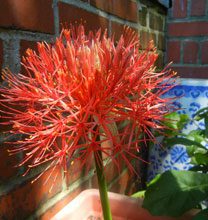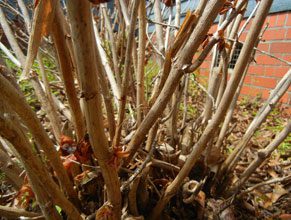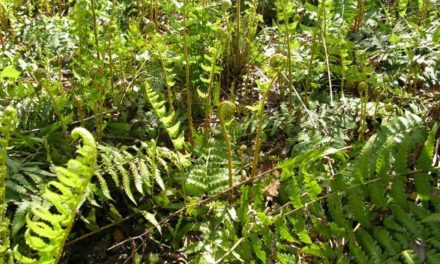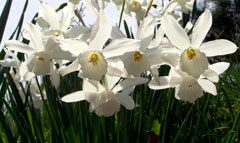 My thumbs are brown these days, it seems; I’m in a rut, dithering, rather than taking the bull by the horns and doing what needs to be done. Much of it is having to constantly face further evidence of the damage in the gardens from the winter-spring weather every time I go out to the garden, suddenly finding planters with beloved Blood Lilies – they used to be named Haemanthus multiflorus, but now are Scadoxus multiflorus – still not arising from “’dormant” bulbs. Or one of the rare and special dogwoods, Cornus kousa “Rosy Teacups,” failing to send out leaves or flowers – or anything!
My thumbs are brown these days, it seems; I’m in a rut, dithering, rather than taking the bull by the horns and doing what needs to be done. Much of it is having to constantly face further evidence of the damage in the gardens from the winter-spring weather every time I go out to the garden, suddenly finding planters with beloved Blood Lilies – they used to be named Haemanthus multiflorus, but now are Scadoxus multiflorus – still not arising from “’dormant” bulbs. Or one of the rare and special dogwoods, Cornus kousa “Rosy Teacups,” failing to send out leaves or flowers – or anything!
They’re dead. Killed by early warm spells in February and March, followed by extended freezing cold in March and April. They, and most of the other plants in the garden, were fooled by the winter’s teasing warmth, fooled into beginning their spring growth too early. And then cruelly killed back by the first freeze, the tender new growth unable to cope with such cold; and, worse, that cold was unrelenting, killing back even the last year’s wood on the Cornus and other plants.
Actually, that’s not what got to the Blood Lilies. They’re often a bit late to start growing from the bulb, so I don’t think the warm/freeze cycle was their downfall. Instead, we mercifully had some decent rains during our winter, a factor which is great for some plants, but which can spell absolute disaster for many others (like many bulbs) which go dormant during winter. Rains and wet soil, coupled with not-actively-growing roots and bulbs, are a prescription for rot. They can turn to mush, sitting in wet soil. If we get a bit of weather warm enough to spur a little root growth, and then cold again, those wet roots will rot twice as fast.
Those plants not killed have suffered merciless losses, as well. None of the Hydrangea macrophyllas will bloom this year. Sure, they’ve mostly come back from the root, but all those big beautiful stems from last year – the stems that would have given me grand blue mopheads of flowers this year – all those stems were killed back. Those bare brown sticks just sat there uglifying those plants, four feet tall, while I futilely hoped they’d show some sign of growing.
 Finally, last week, I went and cut all those old stems out. With the new growth from the base, they look much better, but still. . . I wanted blooms!
Finally, last week, I went and cut all those old stems out. With the new growth from the base, they look much better, but still. . . I wanted blooms!
To be sure, the garden has provided wonderful surprises as well. I discovered that the rare Gordlinia grandiflora tree, still small, had survived and hesitantly had begun its new flush of leaves. The native Oakleaf hydrangeas (H. quercifolia) have plunged headlong into robust growth and, now, flowering. Several varieties of Louisiana Iris – last year’s acquisition – are blooming for the first time in their surprising and wonderful colors.
The weird winter weather turned out to be perfect for the camellias, both the early C. sansanquas and the later C. japonicas, which bloomed exuberantly all winter and even through the post-freeze spring. Now, however, I have to address their even more exuberant post-bloom growth.
My father disregarded the most basic rules of appropriate site selection in planting several varieties of particularly handsome, but vigorous, camellias along the east wall of the farmhouse. Every few years they must be brutally cut back to prevent their ultimately consuming both stories of the 200 year old house. I will eventually have to replace them, of course, with something more fitting; but I always hesitate even to prune them, the show of flowers for October through March is so glorious.
But prune, I must. The camellias and all the other shrubs and small trees which survived those winter/spring freezes, but which had whole branches die back to the trunk. All that dead wood needs to be removed; that will give me the opportunity, too, of shaping the plants a bit and encouraging new growth where it will serve the plant best.
I did notice a number of dead branches on one of our oldest and largest camellias, the huge Camellia sasanqua in the back garden at the farm. Oddly, these were random, entire branches, eight or ten feet long, which seemed to have survived the winter cold without damage, only to have all the leaves turn brown once spring encouraged new growth.
I looked closely and discovered that near the trunk these large branches had been entirely girdled by our resident sapsuckers, woodpecker relatives who drill branches with holes by the hundreds. Some report that the birds are drilling for the sweet sap; some, for the insects just below the bark. It seems some years the sapsuckers just go crazy, completely encircling branches or trunks, cutting through the cambium layer beneath the bark and cutting off the nutrients rising from the roots.
I first encountered this phenomenon some years ago in the amazing camellia gardens of Chelsea plantation in Okatie. Many of their camellias showed remarkable damage from these sapsuckers, but most had recovered well.
That’s what happened here to this old tree, so now I must remove those old now-dead branches. It seems the birds have attacked – but not girdled – almost every branch on the tree. If the rest starts to die back, I’ll just have to do what my father did some thirty years ago. He cut the entire tree back to its trunk about two feet above the ground. Within two years it had grown back impressively, rejuvenated.
Sometimes, starting over is the best alternative.








